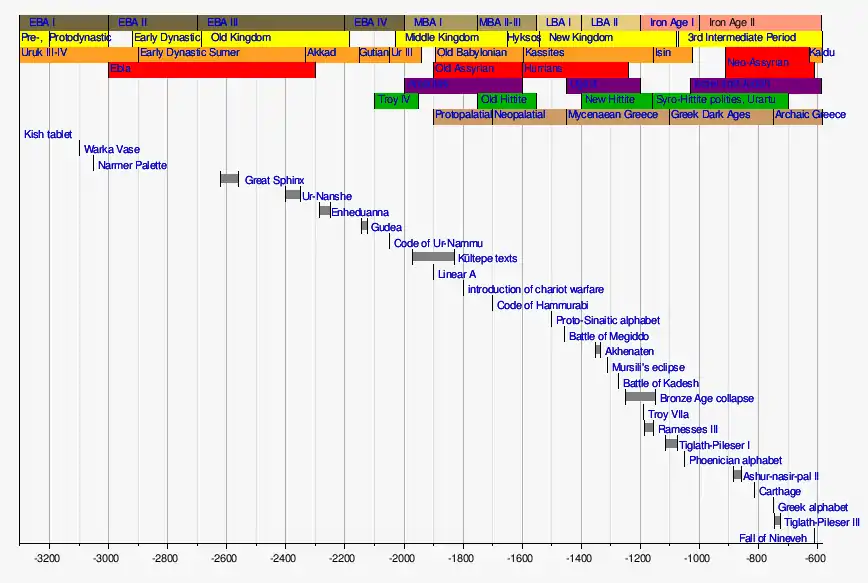Middle chronology
The middle chronology is one chronology of the Near Eastern Bronze and Early Iron Age, which fixes the reign of Hammurabi to 1792–1750 BCE and the sack of Babylon to 1595 BCE.[1]
| The ancient Near East |
|---|
 |
| Regions and states |
|
The Levant |
| Archaeological periods |
| Languages |
| Literature |
| Mythology |
| Other topics |
|
The chronology is based on a 56/64-year astronomical calculation determined by evidence from the Venus tablet of Ammisaduqa and the Enuma anu enlil tablet 63. Conventional textbooks tend to use the middle chronology, but early dendrochronological and astronomical evidence presented various problems for it.[2] This led to increased adoption of the short chronologies by some.[3][4] However, more recent studies have shown that the middle chronology is most likely correct.[5]
The problem raised by using short chronologies is that a century or more needs to be added to some period of the second millennium BCE to accommodate it, but no one so far has been able to make a suggestion as to which period to add it to. That has left second millennium BCE dates appearing artificially short and has resulted in distortion and loss of accuracy for older dates, as a sacrifice to provide greater accuracy for earlier ones.[6]
Various scholars have favoured different chronologies in recent years. Peter J. Huber has favoured the long chronology, relying on astronomical data available from Enuma anu enlil tablets 20 and 21 linking lunar eclipses to historical events in the Ur III period, along with the Venus tablet of Ammisaduqa, Old Babylonian month lengths.[7]
Numerous elements of Huber's theories have been criticized by a consortium of scholars led by Hermann Gasche and Vahe Gurzadyan, who have suggested an ultra-low chronology based on archaeological evidence and especially on more complete use of astronomical evidence. Gasche and Gurzadyan argue that only the eight-year cycle from the Venus tablet is entirely reliable and of practical use[3] (see update in[4]). The latest studies largely rely on more evidences.[4][8] A study from 2001 published high-resolution radiocarbon dates from Turkey supporting dates for the 2nd millennium BC that are very close to those proposed by the middle chronology.[9] Further support for the Middle Chronology (or a "Low-Middle" eight years lower) was provided by a 2016 study combining dendrochronology and radiocarbon.[10]
A table of historical events, by their different chronologies, is shown below.
| Historical event | Ultra-long/Ultra-high chronology | Long/High chronology | Middle chronology | Short/Low chronology | Ultra-short/Ultra-low chronology |
|---|---|---|---|---|---|
| Akkadian Empire | ? | ? | 2334–2154 BCE | 2270–2083 BCE | 2200–2018 BCE |
| Third Dynasty of Ur | ? | 2161–2054 BCE | 2112–2004 BCE | 2048–1940 BCE | 2018–1911 BCE |
| Dynasty of Isin | ? | 2017–1793 BCE | ? | 1922–1698 BCE | |
| First Dynasty of Babylon | ? | 1950–1651 BCE | 1894–1595 BCE | 1830–1531 BCE | 1798–1499 BCE |
| Reign of Hammurabi | 1933–1890 BCE[11] | 1848–1806 BCE | 1792–1750 BCE | 1728–1686 BCE | 1696–1654 BCE |
| Reign of Ammisaduqa | ? | 1702–1682 BCE | 1646–1626 BCE | 1582–1562 BCE | 1550–1530 BCE |
| Fall of Babylon | 1736 BCE[12] | 1651 BCE | 1595 BCE | 1531 BCE | 1499 BCE |
References
- Martin Bernal (1991). Black Athena. Rutgers University Press. pp. 215ff. ISBN 978-0-8135-1584-7.
- Jane McIntosh (2005). Ancient Mesopotamia: New Perspectives. ABC-CLIO. pp. 47–. ISBN 978-1-57607-965-2. Retrieved 3 November 2012.
- Gurzadyan, V. G., On the Astronomical Records and Babylonian Chronology, ICRA, University of Rome “La Sapienza”, Italy and Yerevan Physics Institute, Armenia, Akkadica, v. 119–120 (2000), pp. 175–184.)
- Warburton, D.A., The Fall of Babylon in 1499: Another Update, Akkadica, v. 132, 1 (2011)
- Cornell-led research resolves long-debated Mesopotamia timeline
- , Schwartz, Glenn, 2008. "Problems of Chronology: Mesopotamia, Anatolia, and the Syro-Levantine Region." In: Beyond Babylon: Art, Trade, and Diplomacy in the Second Millennium B.C., edited by Joan Aruz, Kim Benzel, and Jean M. Evans: 450–452.
- Huber, Peter J., Astronomy and Ancient Chronology, Akkadica 119–120 (2000), pp. 159–176.
- Sassmannshausen, Leonhard. Zur mesopotamischen Chronologie des 2. Jahrtausends, Baghdader Mitteilungen 37, 157–177, 2006.
- Manning, S.W.; Kromer, B.; Kuniholm, P.I.; Newton, M.W. (2001). Anatolian Tree Rings and a New Chronology for the East Mediterranean Bronze-Iron Ages. Science. 294. pp. 2532–2535. doi:10.1126/science.1066112. PMID 11743159.
- Sturt W. Manning et al., Integrated Tree-Ring-Radiocarbon High-Resolution Timeframe to Resolve Earlier Second Millennium BCE Mesopotamian Chronology, PlosONE July 13 2016
- Orientalia. Pontificium institutum biblicum. 1998. Retrieved 3 November 2012.
- Eder, Christian. Assyrische Distanzangaben und die absolute Chronologie Vorderasiens, AoF 31, 191–236, 2004.
